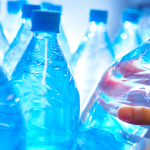This is the only fish we’d like to go extinct!
These tiny plastic soy sauce containers are everywhere – we love them for their cuteness and convenience, but they are proving to be an environmental disaster.
Every serving of sushi we buy automatically comes with a little plastic container of soy sauce, whether we want it or not. These containers are the ultimate example of wastefulness – they are only used for a few moments then thrown away. Ironically, millions of them leak from the waste stream and end up floating amongst real fish in the sea, adding to the mountains of plastic waste choking the world’s oceans, endangering the lives of the animals that live there and threatening the health of the planet.
Soy fish are symbolic of our wasteful, single-use economy where cost and convenience trump environmental responsibility.
It doesn’t have to be this way. Soy sauce only started being packaged in these fish-shaped containers in 2008 when a restaurant in Las Vegas wanted to offer a ‘premium’ soy sauce container with their sushi buffet. The American company Little Soya developed the instantly-recognisable plastic fish-shaped container, and the rest is history. Soy fish are now one of the most ubiquitous sauce containers in the world, manufactured by the millions by dozens of companies and found everywhere sushi is eaten.

What Can I do?
Around the world scientists and entrepreneurs are researching alternatives to plastic that will provide the same convenience, food safety and low cost. Until those products hit the production lines, here are a few things we can all do to keep soy fish out of the environment:
- Next time you buy sushi, give back the soy fish. Politely explain to the server that you don’t want to contribute to the plastic waste already in the ocean, and ask if you can add soy sauce to your sushi from a reusable container. If enough customers do this, the sushi company will get the message. (You can give back that pointless green ‘plastic seaweed’ that sometimes appears in sushi boxes too!)
- Buy your own soy in a glass bottle from the supermarket. Decant a small amount into a smaller, reusable container and take it with you when you plan to have sushi for lunch.
- If you do end up with soy fish, be sure to recycle them. Many (though not all) are made of recyclable plastic but that is not the end of the story. They are so small they fall through the sorting machinery at the recycling center and end up in landfill. The solution is to put them inside a larger plastic container, such as a bottle or takeout food container, and put that in the recycling bin.
But remember, recycling isn’t the answer. Most plastic is typically downcycled—that is, the recycled product is of a lower quality than the original so it can only be recycled a few times before it becomes unusable. The answer to the plastic pollution crisis is not more recycling. Instead we should focus on using less plastic in the first place, especially single-use plastic.
Let’s keep the ocean free of soy fish, for the sake of the real fish!
To help us promote Say NO to soy, our official supporters Critical Slide have created a capsule collection encouraging everyone to choose to refuse the unnecessary single-use plastic.




